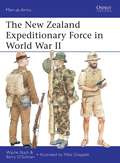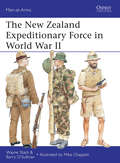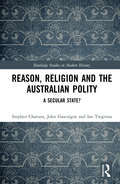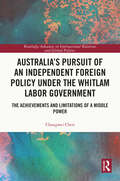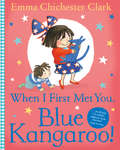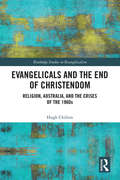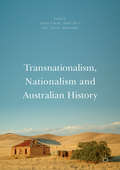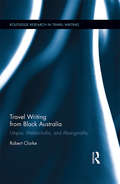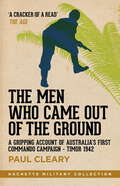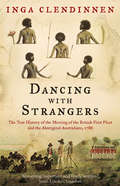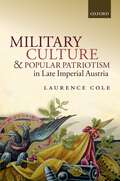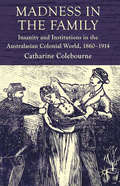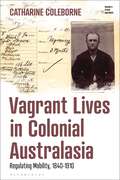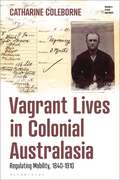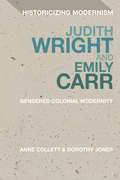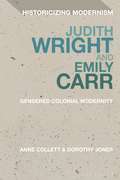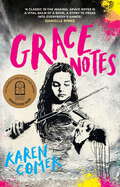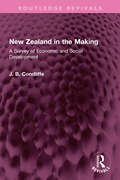- Table View
- List View
The New Zealand Expeditionary Force in World War II (Men-at-Arms)
by Mike Chappell Wayne Stack Barry O’SullivanIn 1939 more than 140,000 New Zealanders enlisted to fight overseas during World War II. Of these, 104,000 served in the Second New Zealand Expeditionary Force. Initially thrown into the doomed campaign to halt the German blitzkrieg on Greece and Crete (1941), the division was rebuilt under the leadership of MajGen Sir Bernard Freyberg, and became the elite corps within Montgomery's Eighth Army in the desert. After playing a vital role in the victory at El Alamein (1942) the 'Kiwis' were the vanguard of the pursuit to Tunisia. In 1943–45 the division was heavily engaged in the Italian mountains, especially at Cassino (1944); it ended the war in Trieste. Meanwhile, a smaller NZ force supported US forces against the Japanese in the Solomons and New Guinea (1942–44). Fully illustrated with specially commissioned colour plates, this is the story of the Second New Zealand Expeditionary Force's vital contribution to Allied victory in World War II.
The New Zealand Expeditionary Force in World War II (Men-at-Arms #486)
by Mike Chappell Wayne Stack Barry O’SullivanIn 1939 more than 140,000 New Zealanders enlisted to fight overseas during World War II. Of these, 104,000 served in the Second New Zealand Expeditionary Force. Initially thrown into the doomed campaign to halt the German blitzkrieg on Greece and Crete (1941), the division was rebuilt under the leadership of MajGen Sir Bernard Freyberg, and became the elite corps within Montgomery's Eighth Army in the desert. After playing a vital role in the victory at El Alamein (1942) the 'Kiwis' were the vanguard of the pursuit to Tunisia. In 1943–45 the division was heavily engaged in the Italian mountains, especially at Cassino (1944); it ended the war in Trieste. Meanwhile, a smaller NZ force supported US forces against the Japanese in the Solomons and New Guinea (1942–44). Fully illustrated with specially commissioned colour plates, this is the story of the Second New Zealand Expeditionary Force's vital contribution to Allied victory in World War II.
Reason, Religion and the Australian Polity: A Secular State? (Routledge Studies in Modern History)
by Stephen A. Chavura John Gascoigne Ian TregenzaHow did the concept of the secular state emerge and evolve in Australia and how has it impacted on its institutions? This is the most comprehensive study to date on the relationship between religion and the state in Australian history, focusing on the meaning of political secularity in a society that was from the beginning marked by a high degree of religious plurality. This book tracks the rise and fall of the established Church of England, the transition to plural establishments, the struggle for a public Christian-secular education system, and the eventual separation of church and state throughout the colonies. The study is unique in that it does not restrict its concern with religion to the churches but also examines how religious concepts and ideals infused apparently secular political and social thought and movements making the case that much Australian thought and institution building has had a sacral-secular quality. Social welfare reform, nationalism, and emerging conceptions of citizenship and civilization were heavily influenced by religious ideals, rendering problematic traditional linear narratives of secularisation as the decline of religion. Finally the book considers present day pluralist Australia and new understandings of state secularity in light of massive social changes over recent generations.
Reason, Religion and the Australian Polity: A Secular State? (Routledge Studies in Modern History)
by Stephen A. Chavura John Gascoigne Ian TregenzaHow did the concept of the secular state emerge and evolve in Australia and how has it impacted on its institutions? This is the most comprehensive study to date on the relationship between religion and the state in Australian history, focusing on the meaning of political secularity in a society that was from the beginning marked by a high degree of religious plurality. This book tracks the rise and fall of the established Church of England, the transition to plural establishments, the struggle for a public Christian-secular education system, and the eventual separation of church and state throughout the colonies. The study is unique in that it does not restrict its concern with religion to the churches but also examines how religious concepts and ideals infused apparently secular political and social thought and movements making the case that much Australian thought and institution building has had a sacral-secular quality. Social welfare reform, nationalism, and emerging conceptions of citizenship and civilization were heavily influenced by religious ideals, rendering problematic traditional linear narratives of secularisation as the decline of religion. Finally the book considers present day pluralist Australia and new understandings of state secularity in light of massive social changes over recent generations.
Australia’s Pursuit of an Independent Foreign Policy under the Whitlam Labor Government: The Achievements and Limitations of a Middle Power (Routledge Advances in International Relations and Global Politics)
by Changwei ChenThe election of the Whitlam-led Labor government in December 1972 ushered in fresh ideas and audacious initiatives in Australia’s foreign policy. Whitlam’s approach was shaped by a vision of taking Australia forward to its "rightful" and "independent" place in the future of the Asia Pacific region. Examining a series of episodes in Australia’s foreign relations under Whitlam, Chen pays attention to a broad range of hitherto insufficiently researched domestic and international issues in Australian’s foreign relations of the early 1970s. They range from immigration policy and the abolition of appeals from Australian Courts to the Privy Council to such major international issues as the Anglo-American base in Diego Garcia, French nuclear testing in the Pacific and the Five Power Agreement with respect to Malaysia and Singapore. Chen demonstrates how the pursuit of foreign policy independence repeatedly placed the Whitlam Government in a position wedged in between Australia’s traditional allies and the Third World; and how it navigated Australia’s national interests on a series of dilemma situations involving conflicting strategic interests between Australia and its traditional allies, and those between major powers and the non-aligned countries. The analysis presented in this book contributes to not only historical literature on the subject but also to the understanding of how a middle power, like Australia, can navigate intensifying great power rivalry. Essential reading for scholars of Australian foreign policy, as well as being an invaluable case study of Middle Power diplomacy in the Asia Pacific region.
Australia’s Pursuit of an Independent Foreign Policy under the Whitlam Labor Government: The Achievements and Limitations of a Middle Power (Routledge Advances in International Relations and Global Politics)
by Changwei ChenThe election of the Whitlam-led Labor government in December 1972 ushered in fresh ideas and audacious initiatives in Australia’s foreign policy. Whitlam’s approach was shaped by a vision of taking Australia forward to its "rightful" and "independent" place in the future of the Asia Pacific region. Examining a series of episodes in Australia’s foreign relations under Whitlam, Chen pays attention to a broad range of hitherto insufficiently researched domestic and international issues in Australian’s foreign relations of the early 1970s. They range from immigration policy and the abolition of appeals from Australian Courts to the Privy Council to such major international issues as the Anglo-American base in Diego Garcia, French nuclear testing in the Pacific and the Five Power Agreement with respect to Malaysia and Singapore. Chen demonstrates how the pursuit of foreign policy independence repeatedly placed the Whitlam Government in a position wedged in between Australia’s traditional allies and the Third World; and how it navigated Australia’s national interests on a series of dilemma situations involving conflicting strategic interests between Australia and its traditional allies, and those between major powers and the non-aligned countries. The analysis presented in this book contributes to not only historical literature on the subject but also to the understanding of how a middle power, like Australia, can navigate intensifying great power rivalry. Essential reading for scholars of Australian foreign policy, as well as being an invaluable case study of Middle Power diplomacy in the Asia Pacific region.
When I First Met You, Blue Kangaroo!
by Emma Chichester ClarkHow the friendship of a lifetime began!The ninth title in this hugely popular series featuring Lily and her loveable soft toy.
Evangelicals and the End of Christendom: Religion, Australia and the Crises of the 1960s (Routledge Studies in Evangelicalism)
by Hugh ChiltonExploring the response of evangelicals to the collapse of ‘Greater Christian Britain’ in Australia in the long 1960s, this book provides a new religious perspective to the end of empire and a fresh national perspective to the end of Christendom. In the turbulent 1960s, two foundations of the Western world rapidly and unexpectedly collapsed. ‘Christendom’, marked by the dominance of discursive Christianity in public culture, and ‘Greater Britain’, the powerful sentimental and strategic union of Britain and its settler societies, disappeared from the collective mental map with startling speed. To illuminate these contemporaneous global shifts, this book takes as a case study the response of Australian evangelical Christian leaders to the cultural and religious crises encountered between 1959 and 1979. Far from being a narrow national study, this book places its case studies in the context of the latest North American and European scholarship on secularisation, imperialism and evangelicalism. Drawing on a wide range of archival sources, it examines critical figures such as Billy Graham, Fred Nile and Hans Mol, as well as issues of empire, counter-cultural movements and racial and national identity. This study will be of particular interest to any scholar of Evangelicalism in the twentieth century. It will also be a useful resource for academics looking into the wider impacts of the decline of Christianity and the British Empire in Western civilisation.
Evangelicals and the End of Christendom: Religion, Australia and the Crises of the 1960s (Routledge Studies in Evangelicalism)
by Hugh ChiltonExploring the response of evangelicals to the collapse of ‘Greater Christian Britain’ in Australia in the long 1960s, this book provides a new religious perspective to the end of empire and a fresh national perspective to the end of Christendom. In the turbulent 1960s, two foundations of the Western world rapidly and unexpectedly collapsed. ‘Christendom’, marked by the dominance of discursive Christianity in public culture, and ‘Greater Britain’, the powerful sentimental and strategic union of Britain and its settler societies, disappeared from the collective mental map with startling speed. To illuminate these contemporaneous global shifts, this book takes as a case study the response of Australian evangelical Christian leaders to the cultural and religious crises encountered between 1959 and 1979. Far from being a narrow national study, this book places its case studies in the context of the latest North American and European scholarship on secularisation, imperialism and evangelicalism. Drawing on a wide range of archival sources, it examines critical figures such as Billy Graham, Fred Nile and Hans Mol, as well as issues of empire, counter-cultural movements and racial and national identity. This study will be of particular interest to any scholar of Evangelicalism in the twentieth century. It will also be a useful resource for academics looking into the wider impacts of the decline of Christianity and the British Empire in Western civilisation.
Transnationalism, Nationalism and Australian History
by Anna Clark Anne Rees Alecia SimmondsUsing Australian history as a case study, this collection explores the ways national identities still resonate in historical scholarship and reexamines key moments in Australian history through a transnational lens, raising important questions about the unique context of Australia’s national narrative. The book examines the tension between national and transnational perspectives, attempting to internationalize the often parochial nation-based narratives that characterize national history. Moving from the local and personal to the global, encompassing comparative and international research and drawing on the experiences of researchers working across nations and communities, this collection brings together diverging national and transnational approaches and asks several critical research questions: What is transnational history? How do new transnational readings of the past challenge conventional national narratives and approaches? What are implications of transnational and international approaches on Australian history? What possibilities do they bring to the discipline? What are their limitations? And finally, how do we understand the nation in this transnational moment?
Transnationalism, Nationalism and Australian History
by Anna Clark Anne Rees Alecia SimmondsUsing Australian history as a case study, this collection explores the ways national identities still resonate in historical scholarship and reexamines key moments in Australian history through a transnational lens, raising important questions about the unique context of Australia’s national narrative. The book examines the tension between national and transnational perspectives, attempting to internationalize the often parochial nation-based narratives that characterize national history. Moving from the local and personal to the global, encompassing comparative and international research and drawing on the experiences of researchers working across nations and communities, this collection brings together diverging national and transnational approaches and asks several critical research questions: What is transnational history? How do new transnational readings of the past challenge conventional national narratives and approaches? What are implications of transnational and international approaches on Australian history? What possibilities do they bring to the discipline? What are their limitations? And finally, how do we understand the nation in this transnational moment?
Travel Writing from Black Australia: Utopia, Melancholia, and Aboriginality (Routledge Research in Travel Writing)
by Robert ClarkeOver the past thirty years the Australian travel experience has been ‘Aboriginalized’. Aboriginality has been appropriated to furnish the Australian nation with a unique and identifiable tourist brand. This is deeply ironic given the realities of life for many Aboriginal people in Australian society. On the one hand, Aboriginality in the form of artworks, literature, performances, landscapes, sport, and famous individuals is celebrated for the way it blends exoticism, mysticism, multiculturalism, nationalism, and reconciliation. On the other hand, in the media, cinema, and travel writing, Aboriginality in the form of the lived experiences of Aboriginal people has been exploited in the service of moral panic, patronized in the name of white benevolence, or simply ignored. For many travel writers, this irony - the clash between different regimes of valuing Aboriginality - is one of the great challenges to travelling in Australia. Travel Writing from Black Australia examines the ambivalence of contemporary travelers’ engagements with Aboriginality. Concentrating on a period marked by the rise of discourses on Aboriginality championing indigenous empowerment, self-determination, and reconciliation, the author analyses how travel to Black Australia has become, for many travelers, a means of discovering ‘new’—and potentially transformative—styles of interracial engagement.
Travel Writing from Black Australia: Utopia, Melancholia, and Aboriginality (Routledge Research in Travel Writing)
by Robert ClarkeOver the past thirty years the Australian travel experience has been ‘Aboriginalized’. Aboriginality has been appropriated to furnish the Australian nation with a unique and identifiable tourist brand. This is deeply ironic given the realities of life for many Aboriginal people in Australian society. On the one hand, Aboriginality in the form of artworks, literature, performances, landscapes, sport, and famous individuals is celebrated for the way it blends exoticism, mysticism, multiculturalism, nationalism, and reconciliation. On the other hand, in the media, cinema, and travel writing, Aboriginality in the form of the lived experiences of Aboriginal people has been exploited in the service of moral panic, patronized in the name of white benevolence, or simply ignored. For many travel writers, this irony - the clash between different regimes of valuing Aboriginality - is one of the great challenges to travelling in Australia. Travel Writing from Black Australia examines the ambivalence of contemporary travelers’ engagements with Aboriginality. Concentrating on a period marked by the rise of discourses on Aboriginality championing indigenous empowerment, self-determination, and reconciliation, the author analyses how travel to Black Australia has become, for many travelers, a means of discovering ‘new’—and potentially transformative—styles of interracial engagement.
The Men Who Came Out of the Ground: A gripping account of Australia's first commando campaign
by Paul Cleary'This account . . . is breathtaking in its scope and riveting in its research' - Sydney Morning HeraldThe gripping story of a small force of Australian Special Forces commandos that launched relentless hit and run raids on far superior Japanese forces in East Timor for most of 1942.These Australians were the men of the 2/2nd Australian Independent Company - a special commando unit. Initially stranded without radio contact to Australia, the Japanese declared these bearded warriors ‘outlaws’ and warned they would be executed immediately if captured. The Australians drawn mainly from the bush, were chosen for their ability to operate independently and survive in hostile territory. As film-maker Damien Parer said after visiting in Timor in late 1942, ‘these men are writing an epic of guerrilla warfare’.Expertly researched by Paul Cleary, who is fluent in Tetum, the main language of the indigenous group of East Timor, it also contains insightful black and white photos.'A cracker of a read' - The Age'Paul Cleary has brought to life one of the great success stories of World War II' - Daily Telegraph
Dancing With Strangers: The True History of the Meeting of the British First Fleet and the Aboriginal Australians, 1788
by Inga ClendinnenIn January of 1788 the First Fleet arrived in New South Wales and a thousand British men and women encountered the people who will be their new neighbours; the beach nomads of Australia. "These people mixed with ours," wrote a British observer soon after the landfall, "and all hands danced together." What followed would determine relations between the peoples for the next two hundred years. Drawing skilfully on first-hand accounts and historical records, Inga Clendinnen reconstructs the complex dance of curiosity, attraction and mistrust performed by the protagonists of either side. She brings this key chapter in British colonial history brilliantly alive. Then we discover why the dancing stopped . . .
Military Culture And Popular Patriotism In Late Imperial Austria
by Laurence ColeMilitary Culture and Popular Patriotism in Late Imperial Austria examines the interplay between popular patriotism and military culture in late imperial Austria. Laurence Cole suggests that two main questions should be asked regarding the western half of the Habsburg Monarchy during the period from the mid-nineteenth century to the outbreak of war in 1914. Firstly, how far did imperial Austrian society experience a process of militarization comparable to that of other European countries? Secondly, how far did the military sphere foster popular patriotism in the multinational state? Various manifestations of military culture, including hero cults and, above all, military veterans associations, provide the main subject for analysis in this volume. After exploring the historical development of military culture in the Habsburg Monarchy, Cole explains how the long reign of Emperor Franz Joseph I constituted a decisive phase in the militarization of Austrian society, with the dynasty and state emphasizing the military's role as the locus of loyalty. Popular manifestations of military culture, such as the hero cult surrounding Field Marshal Radetzky and military veterans associations, complemented the official agenda in many respects. However, veterans associations in particular constituted a political mobilization of the lower middle and lower classes, who asserted their own interests and position in civil society, as is shown by case studies of regions of the Austrian state with significant Italian-speaking populations (Trentino and the Littoral). State attempts to assert greater control of veterans activities led to national and political opposition at a time when tensions over 'militarism' and foreign policy increased. Military Culture and Popular Patriotism in Late Imperial Austria thus raises the question of whether the military was really a bulwark of the multinational state or rather a polarizing force in imperial Austrian society.
Madness in the Family: Insanity and Institutions in the Australasian Colonial World, 1860–1914
by C. ColeborneMadness in the Family explores how colonial families coped with insanity through a trans-colonial study of the relationships between families and public colonial hospitals for the insane in New South Wales, Victoria, Queensland and New Zealand between 1860 and 1914.
Vagrant Lives in Colonial Australasia: Regulating Mobility, 1840-1910 (Empire’s Other Histories)
by Catharine ColeborneInvestigating the history of vagrants in colonial Australia and New Zealand, this book provides insights into the histories and identities of marginalised peoples in the British Pacific Empire. Showing how their experiences were produced, shaped and transformed through laws and institutions, it reveals how the most vulnerable people in colonial society were regulated, marginalised and criminalised in the imperial world. Studying the language of vagrancy prosecution, narratives of mobility and welfare, vagrant families, gender and mobility and the political, social and cultural interpretations of vagrancy, this book sets out a conceptual framework of mobility as a field of inquiry for legal and historical studies. Defining 'mobility' as population movement and the occupation of new social and physical space, it offers an entry point to the related histories of penal colonies and new 'settler' societies. It provides insights into shared histories of vagrancy across New South Wales, Victoria, Tasmania and New Zealand, and explores how different jurisdictions regulated mobility within the temporal and geographical space of the British Pacific Empire.
Vagrant Lives in Colonial Australasia: Regulating Mobility, 1840-1910 (Empire’s Other Histories)
by Catharine ColeborneInvestigating the history of vagrants in colonial Australia and New Zealand, this book provides insights into the histories and identities of marginalised peoples in the British Pacific Empire. Showing how their experiences were produced, shaped and transformed through laws and institutions, it reveals how the most vulnerable people in colonial society were regulated, marginalised and criminalised in the imperial world. Studying the language of vagrancy prosecution, narratives of mobility and welfare, vagrant families, gender and mobility and the political, social and cultural interpretations of vagrancy, this book sets out a conceptual framework of mobility as a field of inquiry for legal and historical studies. Defining 'mobility' as population movement and the occupation of new social and physical space, it offers an entry point to the related histories of penal colonies and new 'settler' societies. It provides insights into shared histories of vagrancy across New South Wales, Victoria, Tasmania and New Zealand, and explores how different jurisdictions regulated mobility within the temporal and geographical space of the British Pacific Empire.
Judith Wright and Emily Carr: Gendered Colonial Modernity (Historicizing Modernism)
by Anne Collett Dorothy JonesKnitting together two fascinating but entirely distinct lives, this ingeniously structured braided biography tells the story of the lives and work of two women, each a cultural icon in her own country yet lesser known in the other's. Australian poet Judith Wright and Canadian painter Emily Carr broke new ground for female artists in the British colonies and influenced the political and social debates about environment and indigenous rights that have shaped Australia and Canada in the 21st century. In telling their story/ies, this book charts the battle for recognition of their modernist art and vision, pointing out significant moments of similarity in their lives and work. Although separated by thousands of miles, their experience of colonial modernity was startlingly analogous, as white settler women bent on forging artistic careers in a male-dominated world and sphere rigged against them. Through all this, though, their cultural importance endures; two remarkable women whose poetry and painting still speak to us today of their passionate belief in the transformative power of art.
Judith Wright and Emily Carr: Gendered Colonial Modernity (Historicizing Modernism)
by Anne Collett Dorothy JonesKnitting together two fascinating but entirely distinct lives, this ingeniously structured braided biography tells the story of the lives and work of two women, each a cultural icon in her own country yet lesser known in the other's. Australian poet Judith Wright and Canadian painter Emily Carr broke new ground for female artists in the British colonies and influenced the political and social debates about environment and indigenous rights that have shaped Australia and Canada in the 21st century. In telling their story/ies, this book charts the battle for recognition of their modernist art and vision, pointing out significant moments of similarity in their lives and work. Although separated by thousands of miles, their experience of colonial modernity was startlingly analogous, as white settler women bent on forging artistic careers in a male-dominated world and sphere rigged against them. Through all this, though, their cultural importance endures; two remarkable women whose poetry and painting still speak to us today of their passionate belief in the transformative power of art.
Grace Notes
by Karen ComerThis song has a grace note,a tiny note that's there for embellishmentbut can easily be ignored,not played.Tonight, I add it in -just because.We can all do with an extra noteof grace.Grace Dalfinch is a talented violinist who longs to play contemporary music in bars, but her mum forbids her. James Crux is an aspiring street artist who promised his dad he wouldn't paint in public until he's finished school. When Crux witnesses Grace's impromptu performance on a deserted tram, he's inspired to paint her and her violin; and when Grace stumbles across her portrait in a Melbourne alley by an anonymous street artist, she sets out to find its creator.Grace Notes is a debut YA verse novel, set in one of the most locked-down cities in the world - Melbourne, 2020. For fans of Cath Crowley and Pip Harry.'A classic in the making; Grace Notes is a vital balm of a book, a story to press into everybody's hands.'DANIELLE BINKS'Poetry, music and art, woven together in an uplifting story about endless lockdowns and first love.'NOVA WEETMAN'Comer captures the beats of Melbourne's 2020 and the unique experience of a generation of teens in one of the most locked-down cities in the world.'Books+Publishing'Heart and soul triumph over Covid lockdowns and restrictions . . . Karen has used the verse novel to beguile, dance and demand layers of emotion and depth that only poetry can sustain. A masterful debut!'LORRAINE MARWOOD'Like the grace note of the title, this beautiful story strikes the perfect tone, mixing colour, light and music at a time when we needed it most.'NICOLE HAYES
New Zealand in the Making: A Survey of Economic and Social Development (Routledge Revivals)
by J. B. CondliffeFirst published in 1930, New Zealand in the Making is an economic history of the democratic experiments in New Zealand. The geography, population, government ownership of public utilities, compulsory arbitration, pensions and all other factors have been covered in detail. The book will be of interest to anyone keen on learning about New Zealand as well as to students of economy, history, agriculture, and government.
New Zealand in the Making: A Survey of Economic and Social Development (Routledge Revivals)
by J. B. CondliffeFirst published in 1930, New Zealand in the Making is an economic history of the democratic experiments in New Zealand. The geography, population, government ownership of public utilities, compulsory arbitration, pensions and all other factors have been covered in detail. The book will be of interest to anyone keen on learning about New Zealand as well as to students of economy, history, agriculture, and government.
